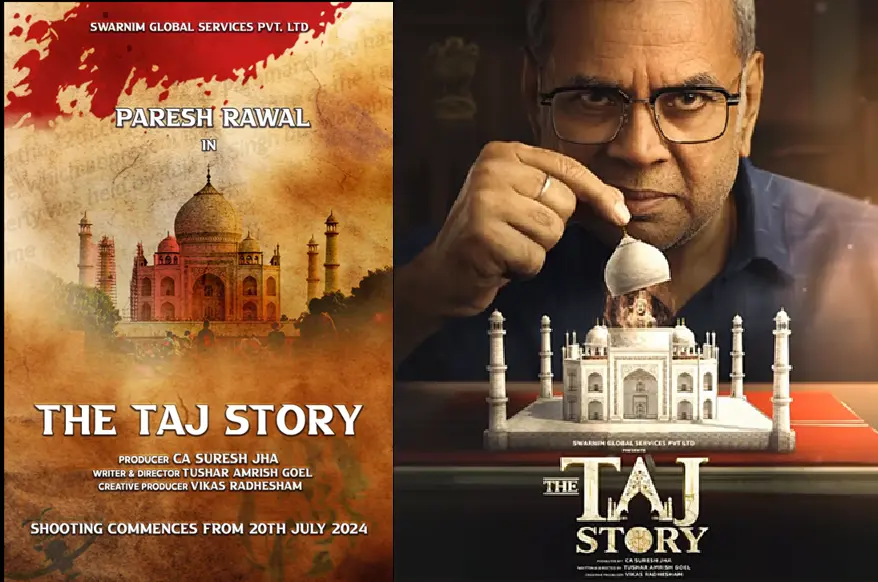
Paresh Rawal’s Taj Story poster triggers backlash over Shiva idol imagery. Makers clarify it’s a historical drama, not a religious statement
Paresh Rawal’s Taj Story Poster Sparks Debate: What’s Really Behind the Controversy?
Published on:
Author: Rapido Updates
The Poster That Sparked a Storm
The Taj Story Poster – On 29th September 2025, veteran actor Paresh Rawal shared the motion poster of his upcoming film The Taj Story on social media. The poster showed Rawal lifting the dome of the Taj Mahal, revealing a Shiva idol inside. The caption read, “What if everything you’ve been taught is a lie? The truth isn’t just hidden; it’s being judged.” This visual quickly went viral and triggered a wave of reactions online.
Many users accused the film of promoting a controversial theory that the Taj Mahal was built over a Hindu temple. This theory has been debated for years but remains unproven and rejected by mainstream historians. The backlash was swift, with critics calling the poster “propaganda” and “fake history.”
Filmmakers Respond with Clarification
Amid the growing criticism, Paresh Rawal deleted the original post and shared an official statement from the film’s production house, Swarnim Global Services Pvt. Ltd.. The statement read:
“The makers of the film The Taj Story clarify that the movie does not deal with any religious matters, nor does it claim that a Shiv temple resides within the Taj Mahal. It focuses solely on historical facts. We would kindly request you to watch the film and form your own opinion.”
Rawal echoed this message in a follow-up post, stating that the film is not about religion but about history. The filmmakers emphasized that the movie aims to explore historical questions and does not intend to hurt sentiments or fuel communal debates.
Public Reaction: Mixed Voices and Heated Opinions
Despite the clarification, the controversy continued. Social media users expressed concern that the film could deepen communal divides. Some compared it to recent films like Gyanvapi Files and The Bengal Files, which were also accused of pushing political narratives.
One user wrote, “The Taj Mahal is the tomb of two lovers. Nothing more than that. All European travelers described it as a mausoleum built by Shah Jahan.” Another said, “Bollywood now pushing propaganda with #TheTajStory. A country boasting of being the 4th largest economy is drowning in fantasy & communal myths.”
Others defended Rawal, saying the film should be judged only after its release. “Let the movie speak for itself. Don’t jump to conclusions based on a poster,” one user commented.
What Is The Taj Story Really About?
Directed by Tushar Amrish Goel and produced by CA Suresh Jha, The Taj Story is set to release on 31st October 2025. The film stars Paresh Rawal in a lead role, alongside Zakir Hussain, Amruta Khanvilkar, Sneha Wagh, and Namit Das. Vikas Radhesham serves as the creative producer.
While the full plot remains under wraps, the makers have hinted that the film explores the “22 sealed doors” of the Taj Mahal and raises questions about India’s intellectual freedom. A teaser released earlier showed Rawal’s character in a courtroom, arguing against “intellectual terrorism.”
The film is described as a “hard-hitting social drama” that dares to present a chapter of Indian history that has never been shown before. Whether it will live up to this promise or stir more controversy remains to be seen.
Taj Mahal: A Monument of Love or a Site of Debate?
The Taj Mahal, built in the 17th century by Mughal emperor Shah Jahan, is one of India’s most iconic monuments. It is recognized globally as a symbol of love and architectural brilliance. However, fringe theories have occasionally claimed that it was originally a Hindu temple named “Tejo Mahalaya.”
These claims have been dismissed by historians due to lack of evidence. The Archaeological Survey of India and international scholars maintain that the Taj Mahal is a Mughal-era mausoleum. Despite this, the debate resurfaces from time to time, often fueled by political or ideological motives.
The Taj Story has now entered this sensitive space, and its impact will depend on how it handles the subject. If it sticks to facts and avoids sensationalism, it could spark meaningful discussion. If not, it risks being labelled as divisive.